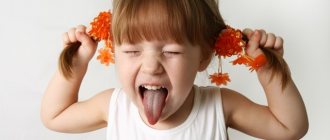dolio.ru » Psychology » Children » Why does a child fight at school and what to do about it?
Every parent dreams that their child will grow up and become an exemplary student, bringing home straight A's. But the first school year begins, and mothers and fathers who had high hopes for the first-grader have to admit that their beloved child is not at all interested in studying. Moreover, their boy is the first bully in the class, from whom you can only expect trouble. What to do in such a situation? Can everything still be fixed?
Children's dirty tricks and punishments - a vicious circle without end and edge
It’s good if a child breaks someone’s ordinary pencil. For this you can simply make a remark. What if he broke someone’s nose or tore their shirt? There is no way to remain silent at this point, and another scandal at home with investigations and punishments is guaranteed. And it will be very effective if this happens very rarely. But the problem is that some children are not just mischievous from time to time, but reward their classmates with heavy blows literally every day. Because of this, parents have to behave extremely cruelly with them, constantly coming up with new forms of punishment.
Unfortunately, practice shows that physical violence or the same reading of morality does not always bring a positive effect. The schoolboy continued to play around and continues to do so. And a fierce battle with parents called “Who will win?” takes the form of a vicious circle, from which it is sometimes simply impossible to get out. Strict mothers and fathers punish the child, and in retaliation he harms them even more. And this can continue until he grows up. But parents hardly dream of building their relationships with their children according to such a sad scenario. Therefore, before it is too late, we propose to understand the true causes of the problem and find ways to solve it.
What to do if a child fights with his parents?
Sometimes pugnacity is due to temperament and lack of education. As a rule, choleric people fight. If the parents have not taught the child socially acceptable ways to resolve contradictions or have shown by personal example that problems need to be solved by fighting, then it is not surprising that the child fights. Especially if temperament contributes to this.
What parental behavior teaches a child to fight:
- personal example;
- permissiveness in education;
- a sweet attitude towards pugnacity, raising a fighter.
In some families, fathers like to cultivate physical strength, especially in boys. Often pugnacity is the result of conscious learning.
In families with several children, pugnacity is a consequence of jealousy. Talk to your child and prove with action that your love is enough for all children. The main thing is to make sure that there really are no favorites, and that everyone gets enough attention.
How to react to fighting, biting, pinching:
- In a calm and serious voice, tell him that it is unpleasant or painful for you. Ask them not to do this. You can pretend to cry or be offended. In this case, you can briefly descend to the level of children's reactions, but only for fun.
- If the child continues to fight, then physically, but not harshly, stop his actions. And repeat that it hurts you, and you can’t behave like that.
- Play insult: do not pick up the child, do not talk to him or play with him. Of course, be sure to explain that he offended you, hurt you, and that’s why you don’t want to communicate with him.
- The child will probably start screaming, crying, and getting angrier. Don't react.
Children live by emotions. They must feel, see and understand the consequences of pugnacious behavior. There is no need to be guided by the attitude “this is a child.” We need to teach him the real model of relationships.
Why does the child behave this way?
At home he is relatively quiet and responds to all comments from adults that he will not do this again. But as soon as he crosses the school threshold, he instantly rushes into a fight, completely forgetting about everything that his parents have been telling him for an hour. There are several reasons for this behavior:
- Too strict control. The stupid desire of parents to control every step of the child forces him to show himself not at his best at school (and even in kindergarten). He does this in order to feel free at least for a while.
- Lack of mutual understanding. Adults are constantly busy with something. Problems at work, solving everyday and financial issues - all this takes up almost all of their time. And only a few manage to find at least a couple of minutes to listen and, most importantly, understand their own child. This is why children withdraw into themselves and, if there are some internal problems, begin to behave uncontrollably. And all because they simply do not know how to find a solution to an issue that is important to them and are trying to do it in their own way.
- The desire to appear better. Arriving at school, each child finds himself in a completely new environment, where it immediately becomes clear that the one who is better will be the first. But you can be the best not only in your studies. You can be the best in a fight. Therefore, if science is not very attractive to a first-grader, he chooses another and apparently simpler way of self-affirmation in a team.
- Inability to communicate with peers. It also happens that one of the main reasons for your child’s excessive “pugnaciousness” may be a simple inability to communicate correctly with peers. He showed him his fist, and he made an ugly face - and the offended boy immediately rushes into a fight. To avoid this, you must first of all explain to him how else you can act in such situations and why.
A year old child fights: what to do?
One-year-old children fight in response to parental prohibitions. At this moment, the child begins to fight for his emancipation. Walking independently is especially important. If parents limit the child’s activity, then a reaction of protest will not be long in coming.
Don't forget about the beginning of the baby's emancipation. Now you are an intermediary between him and the toys, the world. Don't try to direct the child, but follow him. Now he is pulling your hand to go. He asks to get him a toy from the top shelf so he can get to know it. Be attentive to the first notes of independence.
In addition, pugnacity at this time is due to ignorance of other ways to resolve the conflict. Explain to your child that there are other methods. Show by personal example. For example, say that you don't like it when your child fights, but you do it to him because you love him and don't want to hurt him.
How to help a child?
In order for your future man to learn how to behave correctly in society, you need to pay more attention to him from childhood and, if necessary, help him cope with certain problems that arise as he grows up. So, if he began to take too active part in school fights, it is worth paying maximum attention to this issue and figuring out what is the true reason for this behavior.
If you can’t do this on your own, you should talk to the teacher. She sees the children every day and can tell who the real instigator of the fight is and for what reasons. Better yet, go straight to a psychologist who will tell you how to find a way out of a seemingly difficult situation.
Share
What to do if a child fights at school?
Fights at school are most often caused by conflicts in relationships with classmates. In addition, possible reasons include:
- the child's lack of self-confidence;
- violence in family;
- non-acceptance by the team;
- inadequate expression of leadership;
- to attract attention.
If the reason lies in the antisocial nature of the family, then parents need to work on themselves. As long as there is violence at home, as long as parents communicate through fights, and the child is physically punished, the student will continue to fight. No other recommendations will be useful if the root of evil is the family.
What to do if your child fights with other children:
- Explain that you can't fight. Don’t just prohibit it, but explain why: it hurts the other person, it’s offensive, it’s humiliating, it’s bad.
- Explain that first you need to ask for something in a good way, talk calmly. Do this for the first time with your child. Go to his classmate and ask for something.
- Explain that this behavior is unacceptable for your family.
Pugnacity as a result of overwork, irritation, and stress also occurs during the school period. Assess your child’s routine, talk to him, help him organize his schedule, teach him ways to rest.
Do not leave cases of fights unnoticed, but reprimand them in private, without witnesses. Don't use labels like "brawler" - children tend to behave the way they are called. On the contrary, talk about how good the child is. Remember to reward success in curbing aggression. Notice cases where the child was able to solve a problem with words, emphasize this.
A 4 and 5 year old child fights: what to do?
Fights at this age indicate poor self-control. Normally, by this time the child should already have the basics of self-regulation and control over behavior. But this does not happen with inadequate upbringing.
What to do:
- Set clear boundaries and rules of behavior. Consider the extent of sanctions and punishments. Promise only what you will definitely deliver. The child must know that in society it is necessary to adhere to certain norms.
- Don't ignore your child's needs. Chat with him, play. Then he will not have the need to seek attention in this way.
- Encourage initiative, but do not turn it into permissiveness and connivance.
- Game is the leading activity of a preschooler. It's time to teach him not only to play, but also to lose with dignity.
For inveterate fighters aged 2-6 years, family psychologist Elizaveta Filonenko suggests using this method of correcting aggression:
- The next time your child hits, get down to his eye level and grab his wrists firmly, but not painfully, and lightly.
- Looking into the eyes, say in a calm tone: “Listen to me, please. You can't fight."
- Without letting go of your hands, look away and count to 20.
- Turn to your child again and repeat. Let go.
Repeat this exercise after each incident. On average, 3-4 times are enough to reduce pugnacity.
A 2-year-old child fights: what to do?
The main reason for fights at two years old is anger in response to misunderstanding on the part of adults. Children at two years old still speak poorly; parents do not always understand the child’s wishes.
You cannot shout back, let alone beat or scare a child. There is no point in shaming - at this age there is no conscience yet. The tactic “it will form itself” will not work either. What to do:
- Think about what a child might be offended or angry about.
- Do not try to interact with your baby when he is excited. Wait until he calms down at least a little.
- Do not scold or criticize your child. Say, “I love you, but I get upset when you fight.”
- Try to speak out your child’s emotions: “I see that you are upset.” At this age, children know a lot of words and can hint at what is unpleasant for them.
- Try to get to know your child through a game or a fairy tale. Everything that a child shows is not just a figment of the imagination, but also a reflection of his inner world.
- Evaluate your behavior. Learn to see your baby as a full partner. Have you become the provocateur of this behavior?
Under no circumstances should you put your child in a corner, punish or scold him. The best education and correction is personal example. Don't respond to aggression with aggression. However, pugnacity cannot be left unnoticed; it is important to react always and without delay according to the “here and now” principle.
A child’s aggression is a response to stress or the result of energy accumulation. Direct your child's activity in the right direction. Perhaps it’s time to take up sports; it is possible that a little later your child will become interested in martial arts.
A 3-year-old child fights: what to do?
To the reason for the previous age is added the growing egocentrism and the crisis of three years. Firstly, the child believes that the whole world revolves around him, all desires must be fulfilled. If desires are not satisfied, then the first reaction is anger.
Secondly, at this age there is a crisis of “myself”. The child experiences an urgent need for independence. If parents are not ready to provide this freedom, then the child reacts with negativity, insults, and fights.
Give your child adequate freedom and be understanding of the three-year-old crisis. Read more about this in the article “The Crisis of Three Years in a Child.”











